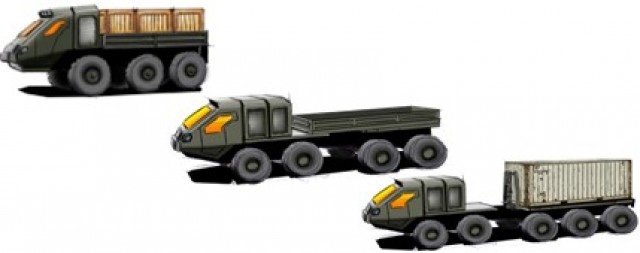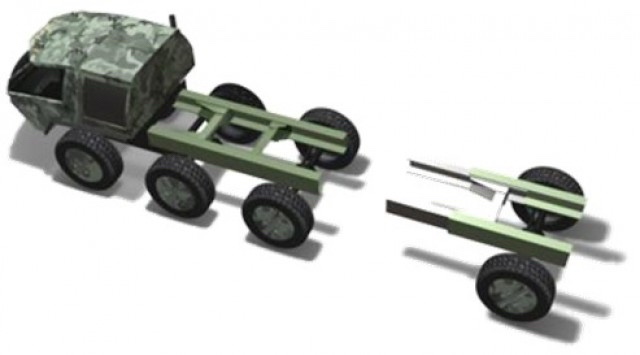
DETROIT ARSENAL, Mich. — With a nod from the Army Futures Command, the Program Executive Office for Combat Support & Combat Service Support will explore the potential use of modified commercial off-the-shelf solutions for a new, common Tactical Wheeled Vehicle, or TWV Fleet.
The Army Requirements Oversight Council on July 30 approved the Common Tactical Truck (CTT) Abbreviated Capabilities Development Document, or A-CDD, which allows the PEO to begin a rapid prototyping effort to provide Army Transporters modernized capabilities while incorporating as much commonality with the commercial trucking industry as possible.
Alvin Bing, the Army’s product manager, Heavy Tactical Vehicles, PEO CS&CSS, explained that dovetailing the CTT program’s desired capabilities with commercial trucking industry research and development projects is a winning proposition.
“Aligning CTT with industry R&D efforts enables rapid and continuous integration of future technologies that can significantly reduce obsolescence issues,” Bing said. “With CTT, the Army wants as much industry involvement as possible so we can increase competition while at the same time, leveraging momentum gained through industry’s rapidly advancing fields of driver safety systems, cybersecurity, artificial intelligence, machine learning, autonomy, improved fuel economy and vehicle electrification, off-road mobility, and predictive maintenance. This will allow the Army to modernize at the pace of industry by integrating new technologies with minimal cost.”
Within the Army’s TWV Fleet, the CTT falls between the Family of Medium Tactical Vehicles and the Heavy Equipment Transporter. CTT seeks to bolster TWV mission roles currently performed by vehicles in the Army’s heavy fleet.
“As the Army’s CTT acquisition lead, our intent is to procure a HTV Family of Vehicles to replace the M915/M1088 Tractors, Heavy Expanded Mobility Tactical Truck, and Palletized Load System with a commercial-based CTT designed with a modular truck platform,” Bing continued. “This will mitigate future obsolescence, leverage best commercial practices, lower procurement costs through commercial economies of scale, and take advantage of interchangeable repair parts across the fleet — resulting in streamlined supply chains and reduced total lifecycle costs.”

According to Don Overton of the Army Futures Command Sustainment Capabilities Integration Directorate’s Requirements Division, ultimately, this effort will inform a future CTT Capability Development Document, which will outline the final, approved operational requirements for a common system that will deliver capability meeting overall operational performance criteria.
“In terms of capability gaps in this portion of the TWV fleet in support of Multi-Domain Operations, we’ve reached design maturity, and without a holistic overhaul, we can’t overcome design limitations and will simultaneously drive operations and sustainment costs to untenable levels. Commercial technologies and economies of scale exist that will help the Army close those gaps and address the increasing age of the current HTV fleet. Now is the right time to modernize with a Common Tactical Truck in support of MDO,” he emphasized.
CTT’s desired characteristics include:
Drive by wire and active safety
Mission roles
Commonality with industry
Digitization (autonomy, prognostics)
Demand reduction
Force protection
Survivability
Sustainment
Industry representatives who are interested in possibly participating in CTT should be on the lookout for announcements and requests for information on SAM.gov in the coming months, Bing said. His acquisition team anticipates holding industry one-on-one meetings tentatively slated for mid-to-late Fiscal Year 2022.
Bing’s team plans to award Other Transaction Authority-based contracts in Fiscal Year 2023 to three vendors to produce multiple prototypes each. OTAs are designed to help the government speed capability to the field vs. traditional contracting methods.
Soldier Touch Points will be leveraged throughout the competitive prototyping phase. These assessments are important ways to incorporate valuable Warfighter feedback into the acquisition program, thereby providing Army Transporters the optimal CTT solution. Currently, the notional plan is for prototype runoff testing to beginning in late Fiscal Year 2023, followed by a down select to a Federal Acquisition Regulation-based production contract in Fiscal Year 2025.
CTT fielding is projected to begin in Fiscal Year 2028.
By Rae Higgins, Program Executive Office, Combat Support & Combat Service Support


Seems like a sensible approach – and I’m digging the design vibe for the Morak mine transportation vehicles from The Mandalorian. 😉
https://lumiere-a.akamaihd.net/v1/images/the-mandalorian-chapter-15-concept-art-02-pqew5944380_b01ec414.jpeg
Going back a little farther…
https://www.youtube.com/watch?v=xzaF93gwUQw
Go Joe!
What about an urgency on getting upgraded/replacement vehicles for the FMTV? These vehicles are the backbone of a lot of units, especially in the Guard and there seems to be an extreme difficulty keeping them running.
Agreed! The FMTV is a workhorse and they are a massive pain in the @$$ to keep running and just like most military vehicles break while parked over the weekend.
I personally would love a version that was a Mobile Command vehicle (think TOC on wheels) and a mobile Battalion Aid Station. Both would be simple game changers in how we rapidly employ and displace our forces on the battlefield.